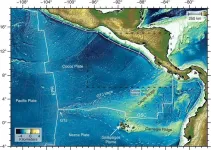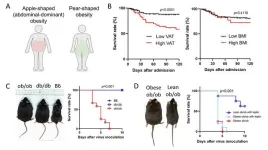(Press-News.org) Ten years ago, Samer Naif made an unexpected discovery in Earth’s mantle: a narrow pocket, proposed to be filled with magma, hidden some 60 kilometers beneath the seafloor of the Cocos Plate.
Mantle melts are buoyant and typically float toward the surface — think underwater volcanoes that erupt to form strings of islands. But Naif’s imaging instead showed a clear slice of semi-molten rock: low-degree partial melts, still sandwiched at the base of the plate some 37 miles beneath the ocean floor.
Then, the observation provided an explanation for how tectonic plates can gradually slide, lubricated by partial melting. The study also “raised several questions about why magma is stored in a thin channel — and where the magma originated from,” says Naif, an assistant professor in the School of Earth and Atmospheric Sciences at Georgia Institute of Technology.
Fellow researchers went on to share competing interpretations for the cause of the channel — including studies that argued against magma being needed to explain the observation.
So Naif went straight to the source.
“I basically went on a multiyear hunt, akin to a Sherlock Holmes detective story, looking for clues of mantle magmas that we first observed in the 2013 Nature study,” he says. “This involved piecing together evidence from several independent sources, including geophysical, geochemical, and geological (direct seafloor sampling) data.”
Now, the results of that search are detailed in a new Science Advances article, “Episodic intraplate magmatism fed by a long-lived melt channel of distal plume origin”, authored by Naif and researchers from the U.S. Geological Survey at Woods Hole Coastal and Marine Science Center, Northern Arizona University, Lamont-Doherty Earth Observatory of Columbia University, the Department of Geology and Geophysics at Woods Hole Oceanographic Institution, and GNS Science of Lower Hutt, New Zealand.
Zeroing in
A relatively young oceanic plate — some 23 million years old — the Cocos Plate traces down the western coast of Central America, veering west to the Pacific Plate, then north to meet the North American Plate off the Pacific coast of Mexico.
Sliding between these two plates caused the devastating 1985 Mexico City earthquake and the 2017 Chiapas earthquake, while similar subduction between the Cocos and Caribbean plates resulted in the 1992 Nicaragua tsunami and earthquake, and the 2001 El Salvador earthquakes.
Scientists study the edges of these oceanic plates to understand the history and formation of volcanic chains — and to help researchers and agencies better prepare for future earthquakes and volcanic activity.
It’s in this active area that Naif and fellow researchers recently set out to document a series of magmatic intrusions just beneath the seafloor, in the same area that the team first detected the channel of magma back in 2013.
Plumbing the depths
For the new study, the team combined geophysical, geochemical, and seafloor drilling results with seismic reflection data, a technique used to image layers of sediments and rocks below the surface. “It helps us to see the geology where we cannot see it with our own eyes,” Naif explains.
First, the researchers observed an abundance of widespread intraplate magmatism. “Volcanism where it is not expected,” Naif says, “basically away from plate boundaries: subduction zones and mid-ocean ridges.”
Think Hawaii, where “a mantle plume of hot, rising material melts during its ascent, and then forms the Hawaii volcanic chain in the middle of the Pacific Ocean,” just as with the Cocos Plate, where the team imaged the volcanism fed by magma at the lithosphere-asthenosphere boundary — the base of the sliding tectonic plates.
“Below it is the convecting mantle,” Naif adds. “The tectonic plates are moving around on Earth's surface because they are sliding on the asthenosphere below them.”
The researchers also found that this channel below the lithosphere is regionally extensive — over 100,000 square kilometers — and is a “long-lived feature that originated from the Galápagos Plume,” a mantle plume that formed the volcanic Galápagos islands, supplying melt for a series of volcanic events across the past 20 million years, and persisting today.
Importantly, the new study also suggests that these plume-fed melt channels may be widespread and long-lived sources for intraplate magmatism itself — as well as for mantle metasomatism, which happens when Earth’s mantle reacts with fluids to form a suite of minerals from the original rocks.
Connecting the (hot spot) dots
“This confirms that magma was there in the past — and some of it leaked through the mantle and erupted near the seafloor,” Naif says, “in the form of sill intrusions and seamounts: basically volcanoes located on the seafloor.”
The work also provides compelling supporting evidence that magma could still be stored in the channel. “More surprising is that the erupted magma has a chemical fingerprint that links its source to the Galápagos mantle plume.”
“We learned that the magma channel has been around for at least 20 million years, and on occasion some of that magma leaks to the seafloor where it erupts volcanically,” Naif adds.
The team’s identified source of the magma, the Galápagos Plume, “is more than 1,000 kilometers away from where we detected this volcanism. It is not clear how magma can stay around in the mantle for such a long time, only to leak out episodically.”
Plume hunters wanted
The evidence that the team compiled is “really quite subtle and requires a detailed and careful study of a suite of seafloor observations to connect the dots,” Naif says. “Basically, the signs of such volcanism, while they are quite clear here, also require high resolution data and several different types of data to be able to detect such subtle seafloor features.”
So, “if we can see such subtle clues of volcanism here,” Naif explains, “it means a similar, careful analysis of high resolution data in other parts of the seafloor may lead to similar discoveries of volcanism elsewhere, caused by other mantle plumes.”
“There are numerous mantle plumes dotted across the planet. There are also numerous seamounts — at least 100,000 of them! — covering the seafloor, and it is anyone’s guess how many of them formed in the middle of the tectonic plates because of magma sourced from distant mantle plumes that leaked to the surface.”
Naif looks forward to continuing that search, from seafloor to asthenosphere.
###
Funding: National Science Foundation: OCE-0625178, U.S. Science Support Program
Citation: DOI: 10.1126/sciadv.add3761
About Georgia Tech
The Georgia Institute of Technology, or Georgia Tech, is one of the top public research universities in the U.S., developing leaders who advance technology and improve the human condition.
The Institute offers business, computing, design, engineering, liberal arts, and sciences degrees. Its more than 45,000 undergraduate and graduate students, representing 50 states and more than 148 countries, study at the main campus in Atlanta, at campuses in France and China, and through distance and online learning.
As a leading technological university, Georgia Tech is an engine of economic development for Georgia, the Southeast, and the nation, conducting more than $1 billion in research annually for government, industry, and society.
END
Scientists unearth 20 million years of ‘hot spot’ magmatism under Cocos plate
A team of scientists led by Georgia Tech have observed past episodic intraplate magmatism and corroborated the existence of a partial melt channel at the base of the Cocos plate
2023-06-20
ELSE PRESS RELEASES FROM THIS DATE:
When it comes to COVID-19, belly fat upsets the apple cart
2023-06-20
Researchers from Tokyo Medical and Dental University (TMDU) find that apple-shaped obesity is associated with cytokine storm and a higher risk of death in COVID-19 patients
Tokyo, Japan – Eating an apple a day may keep the doctor away, but having an apple shape is not nearly as healthy. Now, researchers from Japan have shown that people who carry their weight in their bellies may be at greater risk of poor outcomes if they catch COVID-19.
In a study published last month in Proceedings of the National Academy of Sciences (PNAS), researchers from Tokyo Medical ...
Company culture shapes willingness of workers to act sustainably, research shows
2023-06-20
Amidst rising concerns about the global climate crisis, Princeton researchers have uncovered the surprisingly large role that companies play in shaping sustainable behaviors among employees, as well as a link between eco-friendly behaviors and happier workers.
In research published in Current Research in Ecological and Social Psychology, the Princeton team reported the results from a nationwide study of employees to understand the factors that influence whether workers take sustainable actions and incorporate the environment into their day-to-day decision making.
The results ...
USF Health researchers show how the placenta protects fetus in the womb against viral infections
2023-06-20
Give credit to your dad’s gene for keeping you safe during those long months in your mother’s womb.
Because without this genetic warrior, you might have succumbed to any number of viral infections that otherwise could be fatal to a fetus. A new paper published this week in the journal Cell Host & Microbe explains the mechanisms behind this anti-viral protection.
“What’s unique about this gene is how it produces a form of defense for the baby in the womb,’’ said Hana Totary-Jain, PhD., associate professor of Molecular ...
Outcome indicators make quality of life after childhood cancer measurable
2023-06-20
Outcome indicators make quality of life after childhood cancer measurable
A new measurement tool helps analyzing the survival rate of children with cancer, but also the quality of survival. Researchers at the Princess Máxima Center for Pediatric Oncology have worked with patients and survivors to develop a set of outcome indicators that measure health issues. By making the balance between survival and quality of life measurable, the outcome indicators help improve care for children with cancer.
There are many types of childhood cancer, and the consequences ...
Hidden mechanism connects cancer and diabetes
2023-06-20
Back in the 1920s, researchers discovered that cancer patients had sweet-smelling urine. First, the doctors were puzzled, but they soon realised that it was a result of elevated blood sugar levels.
“This was one of the first things we learned about cancer patients,” says Associate Professor Lykke Sylow.
The sweet-smelling urine suggested that cancer affects the body’s blood sugar level. But how? A new study is ready to answer that question. Where previous studies have examined the connection between cancer and insulin, Lykke Sylow and colleagues’ ...
The meaning behind the Woodstock character in ‘Peanuts’
2023-06-20
COLUMBUS, Ohio – Charles Schulz, creator of the comic strip “Peanuts,” was anything but a hippie.
Still, he named the beloved yellow bird character in “Peanuts” Woodstock after the famous counterculture music festival that was attended and celebrated by the younger generation who grew up in the 1960s and ’70s, including many who saw themselves as hippies.
The question is why, says Michelle Ann Abate, author of the new book Blockheads, Beagles, and Sweet Babboos: New Perspectives on Charles M. Schulz’s Peanuts.
Based on her critical analysis of the strips featuring Woodstock, ...
Restoring the blood-brain barrier?
2023-06-20
There's a bouncer in everyone: The blood-brain barrier, a layer of cells between blood vessels and the rest of the brain, kicks out toxins, pathogens and other undesirables that can sabotage the brain's precious gray matter.
When the bouncer is off its guard and a rowdy element gains entry, a variety of conditions can crop up. Barrier-invading cancer cells can develop into tumors, and multiple sclerosis can occur when too many white blood cells slip pass the barrier, leading to an autoimmune attack on the protective layer of brain nerves, hindering their communication with the rest of the body.
"A leaky blood-brain barrier is a common ...
Combining cancer-targeting virus therapy with radiation to fight brain cancer works better than either treatment on its own: study
2023-06-20
EDMONTON — Combining a cancer-targeting virus with radiation to treat brain cancer in mice was more effective than either therapy on its own according to University of Alberta research, providing hope for new treatments that combine immunotherapy with traditional surgery, chemotherapy or radiation.
The researchers treated mice with glioblastoma brain tumours simultaneously with high-dose radiation and a genetically engineered oncolytic vaccinia virus, a virus that has been used safely as a vaccine against smallpox.
The ...
Exploring the deep connections between adolescent sleep and overall health
2023-06-20
As director of SRI’s Human Sleep Research Program, Fiona Baker studies the complex interplay between sleep and overall health and well-being.
Much of her work has been focused on sleep patterns in adult women, but recently her attention has turned to adolescents. Adolescence is a crucial time for developing healthy sleep patterns as it is for brain development. In her research, Baker draws clear lines of connection between the two.
“Sleep is so important to us all, but especially for teenagers or adolescents,” Baker says. “Between the ages of 10 and 21, or so, and even a little later, the ...
SRI seeks to learn how insects speak through smells
2023-06-20
All around us, insects are speaking to each other: jockeying for mates, searching for food, and trying to avoid becoming someone else’s next meal. Some of this communication is easy to spot—like the flashes of fireflies on a summer night or a screaming chorus of cicadas in the afternoon—but many of the most sophisticated conversations are challenging to observe, occurring through an exchange of chemical scents.
Understanding chemical communication could be the key to finding new, more effective ways to protect crops or ward off biting insects that can transmit diseases. Researchers ...
LAST 30 PRESS RELEASES:
S-species-stimulated deep reconstruction of ultra-homogeneous CuS nanosheets for efficient HMF electrooxidation
Mechanical and corrosion behavior of additively manufactured NiTi shape memory alloys
New discovery rewrites the rules of antigen presentation
Researchers achieve chain-length control of fatty acid biosynthesis in yeast
Water interactions in molecular sieve catalysis: Framework evolution and reaction modulation
Shark biology breakthrough: Study tracks tiger sharks to Maui mating hub
Mysterious iron ‘bar’ discovered in famous nebula
World-first tool reduces harmful engagement with AI-generated explicit images
Learning about public consensus on climate change does little to boost people’s support for action, study shows
Sylvester Cancer Tip Sheet for January 2026
The Global Ocean Ship-Based Hydrographic Investigations Program (GO-SHIP) receives the Ocean Observing Team Award
Elva Escobar Briones selected for The Oceanography Society Mentoring Award
Why a life-threatening sedative is being prescribed more often for seniors
Findings suggest that certain medications for Type 2 diabetes reduce risk of dementia
UC Riverside scientists win 2025 Buchalter Cosmology Prize
SETI Institute opens call for nominations for the 2026 Tarter Award
Novel theranostic model shows curative potential for gastric and pancreatic tumors
How beige fat keeps blood pressure in check
Fossils reveal ‘latitudinal traps’ that increased extinction risk for marine species
Review: The opportunities and risks of AI in mental health research and care
New map reveals features of Antarctic’s ice-covered landscape
Beige fat promotes healthy vascular function and blood pressure in mice
Chronic low-dose pesticide exposure reduces the life span of wild lake fish, China-based study shows
Tiny earthquakes reveal hidden faults under Northern California
Long-term pesticide exposure accelerates aging and shortens lifespan in fish
Professor Tae-Woo Lee's research group develops groundbreaking perovskite display technology demonstrating the highest efficiency and industry-level operational lifetime
The “broker” family helps tidy up the cell
Ecology: Mummified cheetahs discovery gives hope for species’ Arabic reintroduction
Researchers survey the ADHD coaching boom
Air pollution and cardiac remodeling and function in patients with breast cancer
[Press-News.org] Scientists unearth 20 million years of ‘hot spot’ magmatism under Cocos plateA team of scientists led by Georgia Tech have observed past episodic intraplate magmatism and corroborated the existence of a partial melt channel at the base of the Cocos plate


